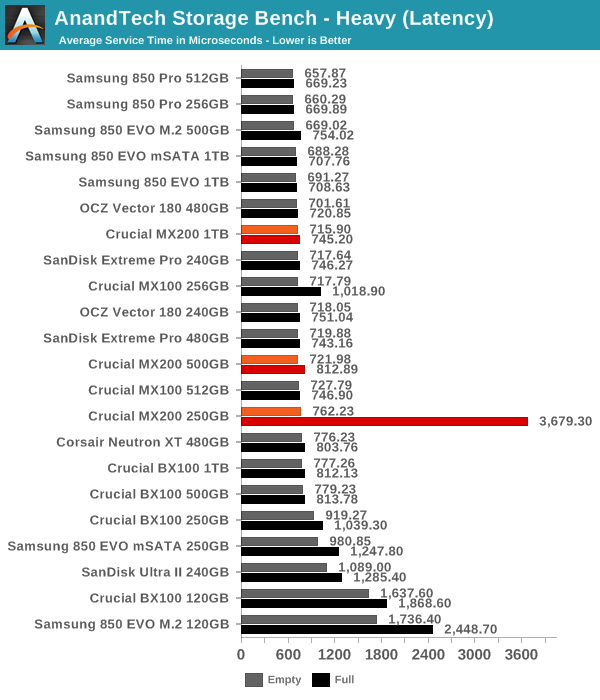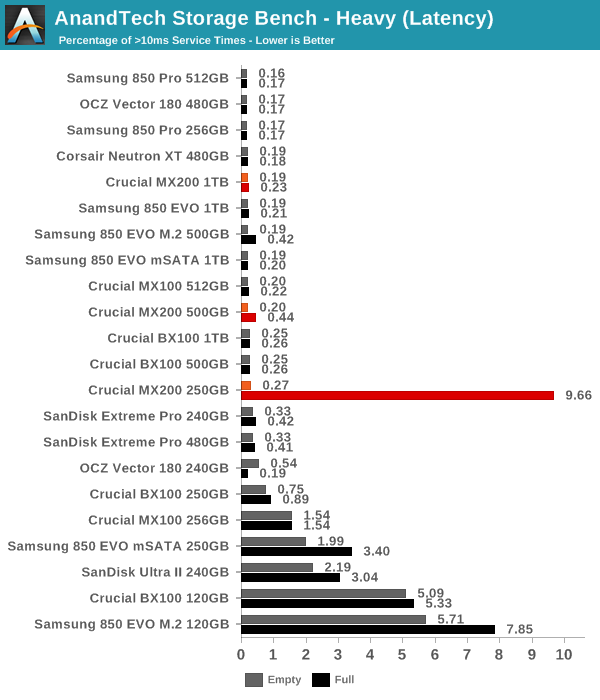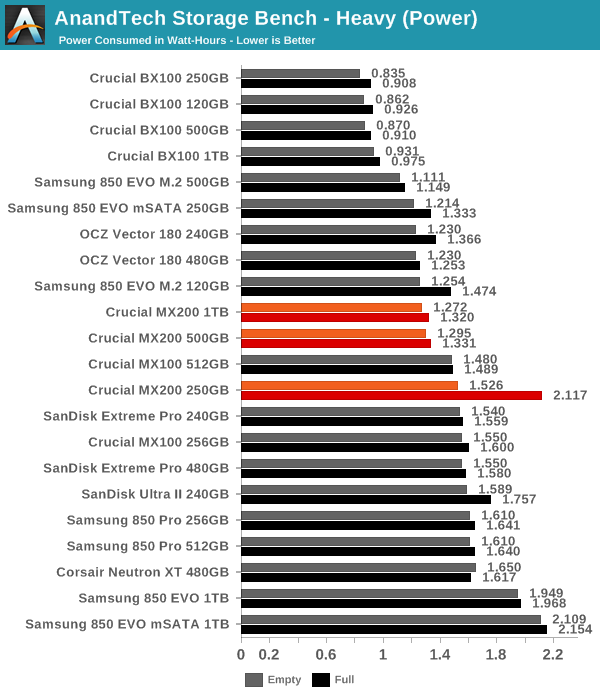Crucial MX200 (250GB, 500GB & 1TB) SSD Review
by Kristian Vättö on May 22, 2015 8:00 AM EST- Posted in
- Storage
- SSDs
- Crucial
- MX200
- Micron 16nm
AnandTech Storage Bench - Heavy
While The Destroyer focuses on sustained and worst-case performance by hammering the drive with nearly 1TB worth of writes, the Heavy trace provides a more typical enthusiast and power user workload. By writing less to the drive, the Heavy trace doesn't drive the SSD into steady-state and thus the trace gives us a good idea of peak performance combined with some basic garbage collection routines. For full details of the test, please refer to the this article.

In our Heavy trace the MX200 is an average drive: it's not as fast as Samsung drives, but roughly on par with the BX100. The most notable data point is the 250GB MX200 in full state because the drop in performance is tremendous, which is due to Dynamic Write Acceleration that is only enabled on the 250GB model. Because DWA writes everything to the SLC cache first, the drive constantly needs to migrate data from SLC to MLC, adding a significant amount of overhead and reducing the performance of host IOs.

The latencies are also good, except for the full 250GB MX200.

Power consumption under load is decent, but not BX100 level. The advantage over Samsung drives is notable, though, so the MX200 appears to be a pretty good fit for a laptop.











62 Comments
View All Comments
KAlmquist - Saturday, May 23, 2015 - link
Take another look at Anandtech Bench. At the 500GB capacity, the mx100 beats the m550 by a small amount across the board. Dropping down to the 250GB capacity affects the write speed of the mx100 more than the write speed of the m550, so the m550 outperforms the mx100 on some benchmarks, but not by a lot. The bottom line is that the m550 and mx100 are close enough in performance that I doubt you would notice any difference in real life usage.petar_b - Sunday, September 4, 2016 - link
I wish I know the answer to that question. I use plenty of M500 and M500, and I really miss them. I don't know if SanDisk could be decent alternative to M550, I don't know how additional features compare to each other (power loss, power management, etc etc). Is there any comprehensive comparison between Micron and SanDisk ??Devo2007 - Friday, May 22, 2015 - link
Small typo on page 3. Under the Destroyer (Data Rate) graph, it says the following:Despite the improved IO consistency, the MX200 doesn't have any advantage over the MX200 in our heaviest The Destroyer trace."
I'm not sure if you meant MX100 or BX100 the second time
XZerg - Friday, May 22, 2015 - link
same on the page 10 under the power consumption chart:but at ~60mW the MX200 enjoys a small benefit over the MX200
Ryan Smith - Friday, May 22, 2015 - link
Thanks. Fixed.Essence_of_War - Friday, May 22, 2015 - link
Yikes, not at all impressed with the DWA in the benchmark workloads! It seems like DWA is a highly dubious feature for a price mark-up over the BX series. At the right price point the larger capacity MX200 w/o DWA (500 and 1TB) still seem like excellent buys, they're just competing super-hard with their BX brethren.olafgarten - Friday, May 22, 2015 - link
I'm still waiting to see what SanDisk does this year.romrunning - Friday, May 22, 2015 - link
Thanks for the good review, Kristian. I liked the call-out on the continued lack of full power-loss protection, and I really liked the constructive criticism in your final words.Shadowmaster625 - Friday, May 22, 2015 - link
why would they even release a product with an slc cache when the slc cache clearly does absolutely nothing?hulu - Friday, May 22, 2015 - link
I'm sure the cache does *something* - mostly when you don't write large amounts of data for minutes on end.The problem with MX200 256GB's implementation is that Crucial is using too much of pseudo-SLC (all the space there is) and the drive ends up driving itself against the wall when the drive fills up. The drive still needs to keep up with the continuing drive writes and at the same time move existing data from SLC to MLC.